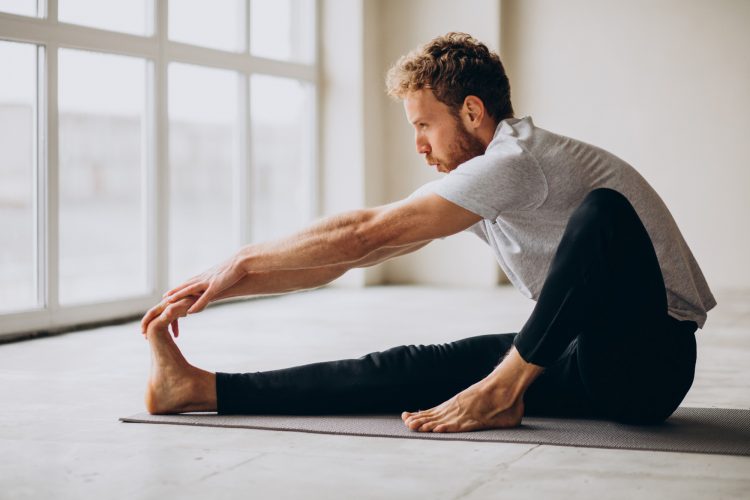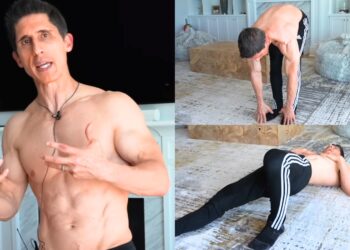Did you know that stretching is not only for post-workout recovery? It can also be used to prepare your mind and body for the best night’s sleep possible.
Research has shown that stretching before bedtime can improve your sleep quality. A study of patients with chronic insomnia found that a moderate-intensity four-month stretching program improved objective and subjective measures of insomnia. (1)
There are several underlying mechanisms to how stretching can help you achieve a better night’s sleep. This article will dive into how stretching can help you sleep better and offer an easy-to-follow stretching routine that you can begin as soon as possible.
The stretches we’ll review below are my top choices for maximizing the time spent stretching and the ones I have used myself working with clients as a physical therapist.
Understanding The Importance of Sleep Quality
Sleep quality is one of the most critical factors in achieving overall health and well-being. It can also impact cognitive function, mood, immune system, and physical health. (1)
Level Up Your Fitness: Join our 💪 strong community in Fitness Volt Newsletter. Get daily inspiration, expert-backed workouts, nutrition tips, the latest in strength sports, and the support you need to reach your goals. Subscribe for free!
Poor sleep quality and restless nights can negatively impact your productivity throughout the day and your ability to adapt to your fitness training. (2)
Several factors can affect sleep quality. These include stress from work, social life, and even poorly timed exercise sessions.
Poorly managed stress can manifest in a poor night’s sleep because the body remains in a ‘fight or flight’ response, which keeps it awake and alert. In this state, heightened adrenaline and cortisol levels signal the body to remain awake. (3)
However, various methods exist to help relieve stress before bed and transition into a more “rest and digest” state conducive to sleep. In this state, there is increased parasympathetic nervous system tone, which at night allows for an increase in melatonin, signaling to the body that it is time to sleep.
Stretching is one of these methods, as it helps to relieve muscle tension and promote relaxation after a stressful day or week.
You can maximize this response by adding deep breathing and mindfulness to your stretching routine.
“The key to better sleep is to set yourself up for success by creating a calming environment and avoiding stimulating activities before bed.” — Andrew Huberman, Ph.D., Neuroscientist
What is Quality Sleep?
Two factors play a role in achieving quality sleep. The first is the number of hours you sleep, and the second is how restorative your sleep is.
Four stages of sleep are categorized into non-rapid eye movement (NREM) and rapid eye movement (REM) stages. (1)
Getting a quality night’s sleep depends on spending ample time in the most vital sleep phase, the third NREM stage, where the body is recovering from daily activities. The stages of sleep are as follows:
NREM 1
This is the lightest stage of sleep, during which you can be easily awakened and may drift in and out of consciousness. (4) In this phase, your brain waves are slower than when you are awake. In this phase, your brain waves show bursts of activity known as sleep spindles.
NREM 2
In this stage, your body temperature, breathing, and heart rate decrease as your brain and body prepare to sleep. Your brain waves show bursts of activity known as sleep spindles.
NREM 3
This is the most vital phase of sleep, and the sooner and longer you can spend in it, the higher quality sleep you will achieve. In this phase, the body’s tissues are repaired, and the immune system is strengthened. If you’ve ever woken up feeling groggy or disoriented, you were likely in deep sleep.
REM
Most people consider this phase of sleep the most important. However, in this phase, the body shifts from recovering tissues to consolidating memories, dreaming, and learning. This phase is characterized by rapid eye movement, vivid dreams, and heightened brain activity. (4)
By developing a pre-bedtime stretching routine, you can transition your body and mental state into one that is prepared for sleep and more easily begin your journey through these phases.
How Pre-Bedtime Stretching Improves Sleep Quality
This is how stretching before bed can be beneficial:
Muscle Relaxation & Blood Flow
There are many responses within the body from stretching that can contribute to increasing your sleep quality.
For starters, stretching can promote increased blood flow to the target muscles. After stretching, a subsequent increase in blood flow brings oxygen and nutrients to the area while removing metabolic waste products that may have accumulated throughout the day. (5)
This increased blood flow can contribute to decreased muscle tension and promote relaxation.
Stretching before bedtime can also stimulate the release of endorphins, the body’s feel-good hormones, which further increase mental state and relaxation.
Level Up Your Fitness: Join our 💪 strong community in Fitness Volt Newsletter. Get daily inspiration, expert-backed workouts, nutrition tips, the latest in strength sports, and the support you need to reach your goals. Subscribe for free!
Lastly, a stretching routine before bed can help take your mind off things causing you anxiety.
Reduced Muscle Tension
Various daily activities can lead to increased muscle tension and subsequent poor night sleep. Prolonged sitting or standing, repetitive work motions, or intense exercise can all cause muscle stiffness.
You can target these problem areas by consistently stretching before bedtime and ensuring they don’t prevent you from falling asleep. If the stiffness you are experiencing is causing you physical pain, such as back pain, stretching may benefit you.
A simple five to 10-minute stretching routine may be all you need to reduce your pain and fall asleep.
Stimulating Parasympathetic Tone
The parasympathetic nervous system (PNS) is heavily involved in activities that require a more peaceful and restorative atmosphere. These include eating, socializing, and sleeping, where you are looking for downregulation of the body’s systems.
Stretching, combined with deep breathing, helps stimulate the PNS and counteract the sympathetic nervous system’s (SNS) effects. (6)
The SNS is involved in situations where swift and aggressive action or focus is required. These situations range from self-defense to running from an animal or taking an important test.
All of these are stressful, but the SNS can remain stimulated by less obvious things, such as exercise that doesn’t have planned rest days, underfueling between workouts, and stress from work or family life.
Daily stretching before bed can help you ground yourself and achieve a more restful nervous system state, lower cortisol levels, and give you a better night’s sleep. (6)
6 Stretches For Better Sleep
When setting up your pre-bedtime stretching routine, assigning one stretch per major joint will do just fine to capture as many muscles as possible.
You can also alternate different stretches on different days or select specific stretches based on your needs.
For example, if you have a job that requires you to sit all day, then targeting your hip flexors, core, and lower back would be best as they may be shortened for most of the day.
You can use this outline as a starting point for your stretching routine.
Upper Trap Stretch
- Begin sitting upright with a relaxed but good posture.
- Place one hand under the same side hip, extending the arm.
- Keeping a neutral cervical spine, laterally tilt your head away from the arm under the hip.
- Continue side bending until a stretch is felt in the upper trap, and hold for several seconds.
- Repeat on the opposite side.
Child’s Pose
- Begin on your hands and knees.
- Walk both hands out as far as they can go so that the shoulder is fully flexed and the latissimus dorsi muscle is lengthened.
- Initiate the stretch in the shoulders by sitting the hips back towards the heels.
- Descend as far as your shoulders, hips, and knees will allow.
- Hold for several seconds.
Cat-Cow
- Begin on your hands and knees.
- Press your upper back to the sky in a fluid motion, feeling a stretch in the spine.
- As your upper back peaks, flex the chin to lengthen the cervical spine.
- Hold for several seconds.
- Reverse direction by pulling the shoulder blades together and arching the chest up.
- At the lowest point, extend the neck to bring the head up.
- Hold for several seconds, then repeat.
Couch Stretch
- Begin by dropping into a kneeling position on the floor with your back toward a couch or bench.
- Raise the target leg so the knee is down and the front of the ankle rests on the surface.
- Assume an upright lunge position with the core braced.
- Push the hips back towards the couch to lengthen the quadriceps and hip flexor of the target leg.
- Hold for several seconds, then repeat on the opposite side.
Supine Hamstring Stretch
- Begin by lying on your back.
- Place a band, strap, or belt around the target leg’s foot.
- Maintaining the extension of the opposite leg on the floor, raise the target leg as far as possible.
- Once a stretch sensation is felt in the target hamstring, apply overpressure with the hands and band.
- Continue until a gentle stretch is felt, and hold for several seconds.
- Repeat on the opposite side.
Ankle Dorsiflexion Stretch
- Begin standing in front of a wall, couch, or squat rack.
- Place the target foot onto the wall, maintaining full knee extension.
- Use the arms to pull the torso towards the wall until a stretch is felt in the calf of the target leg.
Additional Techniques To Incorporate With Stretching
You can use various techniques to augment your stretching exercises and further increase their effect on your ability to achieve a better night’s sleep. Try these techniques in addition to stretching.
Deep Breathing Exercises
The breath is incredibly powerful in decreasing muscle tension and augmenting the parasympathetic nervous system. (7) To perform deep breathing correctly, you will want to emphasize the contraction of the diaphragm and avoid using accessory breathing muscles such as the upper traps.
To perform deep breathing with the diaphragm, slowly inhale through your nose with your mouth shut and your tongue on the roof of your mouth. As you inhale, focus on expanding the belly both forward and laterally.
Once you have maximally inhaled, exhale slowly through “pursed lips,” similar to bowing out a candle.
“You should always be able to take a full breath while doing any kind of mobilization. Breathing is a great built-in “intensity gauge.” Listen to your own body. That’s the best gauge of all.” — Dr. Kelly Starrett, Physical Therapist
Meditation
Before performing your stretches, you can engage in various meditation techniques to quiet your mind and relieve stress from your day.
A simple way to start meditating is to sit with your eyes closed, breathing in and out of your nose with your focus on your breath for several minutes.
Proprioceptive Neuromuscular Facilitation (PNF)
PNF techniques increase the flexibility of a target muscle by tapping into the nervous system and more quickly expanding the range of motion.
During a PNF technique, the target muscle performs a gentle isometric contraction after several seconds of stretching to override the stretch reflex and allow for muscle relaxation and a deeper stretch.
To perform a PNF contraction, stretch the target muscle for 30 to 60 seconds, perform an isometric contraction against an immovable object for five to 10 seconds, relax, and then move the target limb further into the stretch position.
Final Thoughts on Stretching Before Bed
Developing a consistent stretching routine before bed can help you achieve a higher sleep quality.
By harnessing the physiological mechanisms that occur under the hood as you stretch, you can shift your body away from the stress of your day and into a calmer mental state.
If you regularly exercise before bed, stretching combined with other techniques like meditation or deep breathing can help downregulate your system and promote recovery.
Start a pre-bedtime stretching routine by utilizing the exercises I mentioned above. You can also use them as a guide to develop your own personalized routine based on your needs — as long as it’s a routine you can stick to and enjoy doing!
References:
- D’Aurea, C. V. R., Poyares, D., Passos, G. S., Santana, M. G., Youngstedt, S. D., Souza, A. A., Bicudo, J., Tufik, S., & de Mello, M. T. (2019). Effects of resistance exercise training and stretching on chronic insomnia. Revista brasileira de psiquiatria (Sao Paulo, Brazil : 1999), 41(1), 51–57. https://doi.org/10.1590/1516-4446-2018-0030
- Vitale, K. C., Owens, R., Hopkins, S. R., & Malhotra, A. (2019). Sleep Hygiene for Optimizing Recovery in Athletes: Review and Recommendations. International journal of sports medicine, 40(8), 535–543. https://doi.org/10.1055/a-0905-3103
- Hannibal, K. E., & Bishop, M. D. (2014). Chronic stress, cortisol dysfunction, and pain: a psychoneuroendocrine rationale for stress management in pain rehabilitation. Physical therapy, 94(12), 1816–1825. https://doi.org/10.2522/ptj.20130597
- Patel AK, Reddy V, Shumway KR, et al. Physiology, Sleep Stages. [Updated 2024 Jan 26]. In: StatPearls [Internet]. Treasure Island (FL): StatPearls Publishing; 2024 Jan-. Available from: https://www.ncbi.nlm.nih.gov/books/NBK526132/
- Matsuo, H., Kubota, M., Shimada, S., Kitade, I., Matsumura, M., Nonoyama, T., Koie, Y., Naruse, H., Takahashi, A., Oki, H., Kokubo, Y., & Matsumine, A. (2022). The Effect of Static Stretching Duration on Muscle Blood Volume and Oxygenation. Journal of strength and conditioning research, 36(2), 379–385. https://doi.org/10.1519/JSC.0000000000003457
- Eda, N., Ito, H., & Akama, T. (2020). Beneficial Effects of Yoga Stretching on Salivary Stress Hormones and Parasympathetic Nerve Activity. Journal of sports science & medicine, 19(4), 695–702. https://pubmed.ncbi.nlm.nih.gov/33239943/
- Stromberg, S. E., Russell, M. E., & Carlson, C. R. (2015). Diaphragmatic breathing and its effectiveness for the management of motion sickness. Aerospace medicine and human performance, 86(5), 452–457. https://doi.org/10.3357/AMHP.4152.2015










